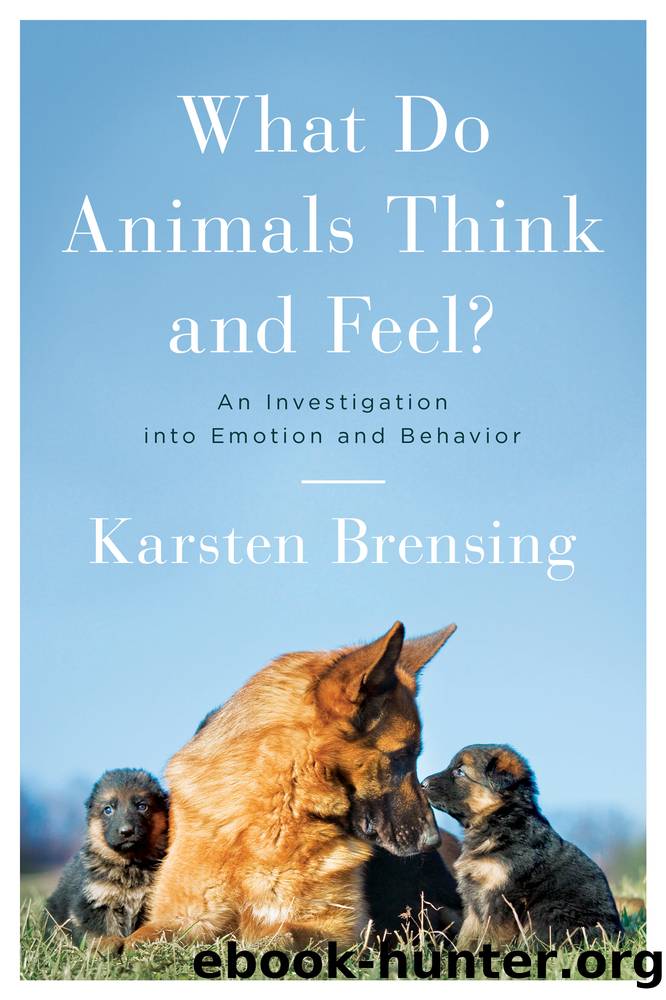What Do Animals Think and Feel? by Karsten Brensing

Author:Karsten Brensing
Language: eng
Format: epub
Publisher: Pegasus Books
Published: 2020-10-06T00:00:00+00:00
* * *
Mathematics
Letâs stay with the Ancient Greeks for a bit. Perhaps you will recall the legend of Prometheus. He bamboozled Zeus with a trick and was severely punished for it. The trick was very simple: Prometheus knew that Zeus was a greedy skinflint and always took the largest portion for himself. Accordingly, he divided an animal he had sacrificed into two piles of meat. The smaller pile contained the choicest cuts, while the larger one comprised nothing but the bones, sinews, fat and skin. As anticipated, Zeus took the larger pile, thus showing that he knew set theory. He shared this capacity with most animals, as it is extremely practical to be able to tell what is larger. But when you consider that algebra, analysis, geometry and stochastic (that is, randomly determined) processes are also branches of set theory, youâll quickly appreciate what significance this basic ability has.
Over and above this, many animals can count, at least up to four. There is a nice article on this topic on Wikipedia,48 so Iâll refrain from listing all the many examples and experiments that go to prove it. But you might still enjoy the following anecdote.49 At the Institute for Marine Mammal Studies in Mississippi, USA, a dolphin by the name of Kelly displayed some quite incredible behaviour. The dolphins there were trained to collect litter from the pool, and were given a small fish each as a reward. One day, rather than bringing it to the trainer, Kelly chose to hide a little scrap of paper she had found, possibly because she wasnât particularly hungry. That in itself is a remarkable achievement on the dolphinâs part. Kelly had shown that she possessed a large measure of self-control. (The term used for this in scientific circles is inhibitory control, and in the normal course of events it is only ascribed to humans; weâll treat this subject further in the section on âTheory of mindâ; pp. 222â4.) In addition, Kelly displayed an understanding of time and made clear that she also grasped the theory of trade, since ultimately she was treating the scrap of paper like currency, which she could trade in for fish whenever she felt like it. But that wasnât the end of her creativity. No one had defined how large or small a piece of paper had to be to earn a reward, so Kelly came up with the idea of tearing the piece she had found into several smaller pieces so that she could claim repeated rewards. It seems incredible â but thereâs even better to come.
One day, she managed to catch a seagull and brought it to her trainer. He was thrilled and gave her several fish as a reward. So then Kelly hit upon a brilliant idea. Taking one of the fish, she positioned it in such a way that seagulls could easily get at it. Then she lay in wait, and was able to catch the next seagull and trade it in once again for some more fish.
Download
This site does not store any files on its server. We only index and link to content provided by other sites. Please contact the content providers to delete copyright contents if any and email us, we'll remove relevant links or contents immediately.
| Administration & Medicine Economics | Allied Health Professions |
| Basic Sciences | Dentistry |
| History | Medical Informatics |
| Medicine | Nursing |
| Pharmacology | Psychology |
| Research | Veterinary Medicine |
Bioenergetica by Alexander Lowen(1429)
The Child in You by Stefanie Stahl(1207)
No Bad Parts by Richard C. Schwartz(1178)
Noise: A Flaw in Human Judgment by Sunstein Cass R. & Sibony Olivier & Kahneman Daniel(1156)
The Data Detective by Tim Harford(1103)
Chatter by Ethan Kross(1027)
The Science of Rapid Skill Acquisition by Peter Hollins(870)
The Quantum Psychiatrist: From Zero to Zen Using Evidence-Based Solutions Beyond Medication and Therapy by Biswas Dona(836)
Freedom by Sebastian Junger(819)
The Montessori Baby by Simone Davies(792)
Maps of Meaning: The Architecture of Belief by Jordan B. Peterson(708)
The Science of Self-Learning: How to Teach Yourself Anything, Learn More in Less Time, and Direct Your Own Education (Learning how to Learn Book 1) by Peter Hollins(692)
Evolution Gone Wrong: The Curious Reasons Why Our Bodies Work by Alex Bezzerides(672)
Sadomasochism and the BDSM Community in the United States by Stephen K. Stein(656)
Anxiety For Dummies by Charles H. Elliott & Laura L. Smith(636)
Why Sex Doesn't Matter by Olivia Fane(630)
Disconnected by thomas Kersting(621)
Jung - The Key Ideas: Teach Yourself (TY Philosophy) by Ruth Snowden(596)
The Mechanics of Passions: Brain, Behaviour, and Society by Alain Ehrenberg(593)
